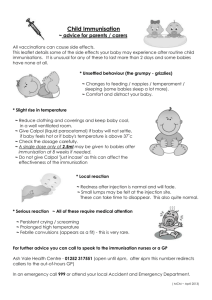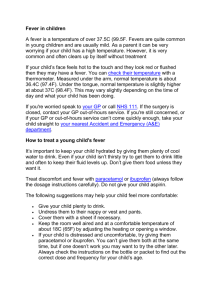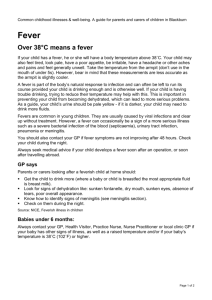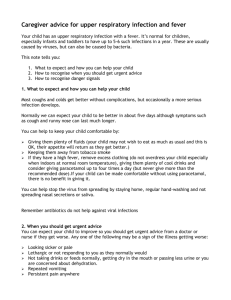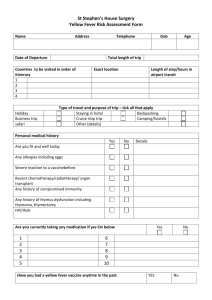What to expect - Craig Nevis Surgery
advertisement
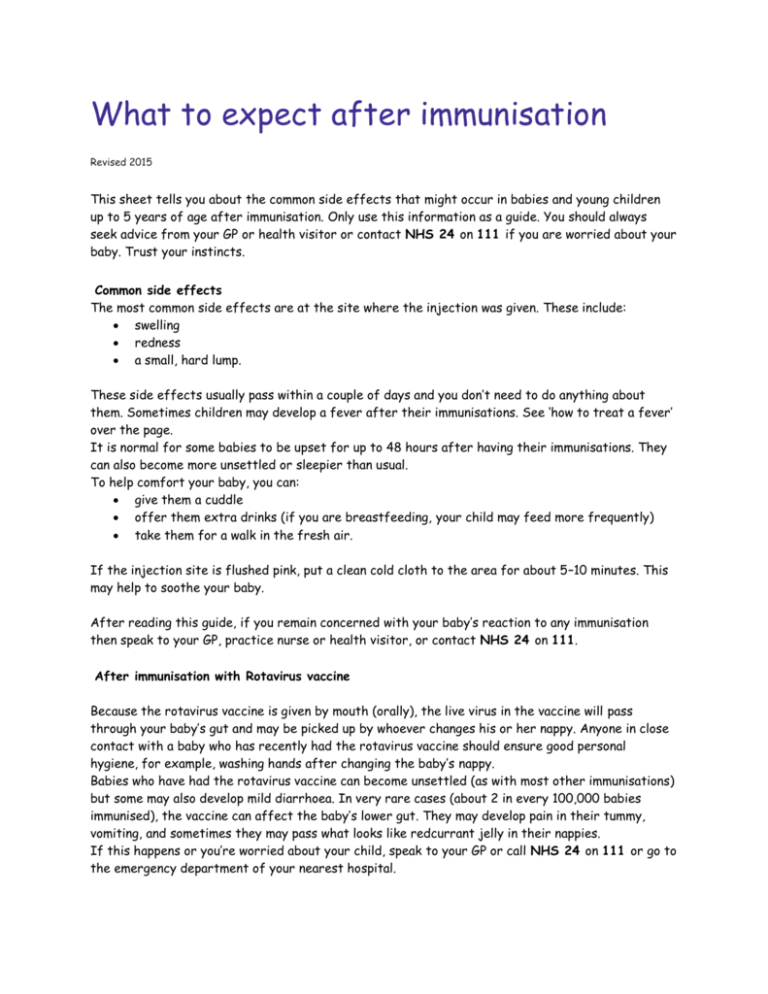
What to expect after immunisation 5 years Revised 2015 This sheet tells you about the common side effects that might occur in babies and young children up to 5 years of age after immunisation. Only use this information as a guide. You should always seek advice from your GP or health visitor or contact NHS 24 on 111 if you are worried about your baby. Trust your instincts. Common side effects The most common side effects are at the site where the injection was given. These include: swelling redness a small, hard lump. These side effects usually pass within a couple of days and you don’t need to do anything about them. Sometimes children may develop a fever after their immunisations. See ‘how to treat a fever’ over the page. It is normal for some babies to be upset for up to 48 hours after having their immunisations. They can also become more unsettled or sleepier than usual. To help comfort your baby, you can: give them a cuddle offer them extra drinks (if you are breastfeeding, your child may feed more frequently) take them for a walk in the fresh air. If the injection site is flushed pink, put a clean cold cloth to the area for about 5–10 minutes. This may help to soothe your baby. After reading this guide, if you remain concerned with your baby’s reaction to any immunisation then speak to your GP, practice nurse or health visitor, or contact NHS 24 on 111. After immunisation with Rotavirus vaccine Because the rotavirus vaccine is given by mouth (orally), the live virus in the vaccine will pass through your baby’s gut and may be picked up by whoever changes his or her nappy. Anyone in close contact with a baby who has recently had the rotavirus vaccine should ensure good personal hygiene, for example, washing hands after changing the baby’s nappy. Babies who have had the rotavirus vaccine can become unsettled (as with most other immunisations) but some may also develop mild diarrhoea. In very rare cases (about 2 in every 100,000 babies immunised), the vaccine can affect the baby’s lower gut. They may develop pain in their tummy, vomiting, and sometimes they may pass what looks like redcurrant jelly in their nappies. If this happens or you’re worried about your child, speak to your GP or call NHS 24 on 111 or go to the emergency department of your nearest hospital. After immunisation with MMR Side effects of the MMR vaccine may include: After 6–10 days the measles vaccine starts to work and may cause a fever, a measles-like rash and a loss of appetite. Around 2–3 weeks after the injection the mumps vaccine may cause mumps-like symptoms (fever and swollen glands) in some children. Most commonly, around 12–14 days after the injection the rubella vaccine may cause a brief rash and possibly a slightly raised temperature and, on rare occasions, a rash may also occur up to six weeks later. If you are worried about your child, trust your instincts. Speak to your GP or call NHS 24 on 111 or go to the emergency department of your nearest hospital. Call your GP immediately if, at any time, your child has a temperature of 39–40°C or above, or has a fit. How to treat a fever A fever is a body temperature over 37.5°C. Fevers are quite common in young children, but are usually mild. If your child’s face feels hot to the touch and they look red or flushed, he or she may have a fever. You can check their temperature with a thermometer. Keep your child cool by: making sure they don’t have too many layers of clothes or blankets on (take off clothes) switching down the house heating giving them plenty of cool drinks (if you are breastfeeding, your child may feed more frequently) not putting them in a bath, sponging them down or putting a fan on them (there is no evidence that this will lower your child’s fever). As fevers are usually mild, you only need to give a dose of infant paracetamol if your child appears uncomfortable or unwell. Read the instructions on the bottle very carefully. See separate advice in the box opposite about using paracetamol after the MenB vaccine at 2 and 4 months of age. After immunisation with MenB – information about paracetamol Fever can be expected after any immunisation, but is more common when the MenB vaccine is given with the other routine vaccines at 2 and 4 months of age. This is why paracetamol is recommended in this instance to prevent and treat fever. Your baby will have been given the first dose of infant paracetamol along with the routine immunisations. The nurse will have advised you how to get paracetamol for two further doses which you should give to your baby as follows: Age of baby 2 months to 4 months Dose 1 paracetamol one 2.5 ml (60 mg) dose along with their immunisations Dose 2 paracetamol one 2.5 ml (60 mg) dose 4– 6 hours after dose 1 Dose 3 paracetamol one 2.5 ml (60 mg) dose 4–6 hours after dose 2 The 2.5 ml (60 mg) dose should be measured and given either using a syringe or with a 2.5 ml spoon (this is usually the small end of the spoon that comes in the pack). This expert advice on the use of paracetamol only applies if your baby has had the MenB vaccine with the other routine vaccines at 2 and 4 months of age. If your baby has a fever at any other time you should follow the instructions and dose advice on the product packaging and patient information leaflet. Although paracetamol is safe in very young children, the current advice for non-vaccine fever is that no more than two doses should be given to babies aged 2–3 months, without seeking the advice of a GP or pharmacist. This is to ensure that fever which may be due to a serious infection in babies of this age is quickly diagnosed and treated. Fever is much less common when the MenB booster is given at 12 months of age so paracetamol is not always needed then. However, if your baby does develop a fever, is irritable, or unwell, then you can give them infant paracetamol if you wish. For very premature babies (born before 32 weeks gestation) or very small babies (less than 3 kg), paracetamol should be prescribed by your GP according to the baby’s weight at the time of immunisation. You should check with your GP and follow the instructions on the prescription.


